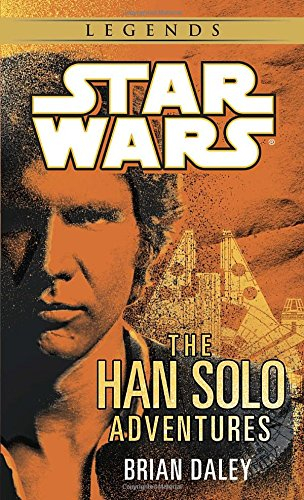Retro Book Review: “The Han Solo Adventures” by Brian Daley
With Ron Howard’s movie Solo: A Star Wars Story coming to audiences on the big screen, fans and newcomers to the Star Wars world are about to learn about the early days of Han Solo. Where did he come from? What made him the man we saw Harrison Ford portray for four movies? As mentioned in my reviews for Ann Crispin’s Han Solo trilogy of books from the Star Wars Legends series, there are lots of places to further your journey with the Corellian smuggler.
The Han Solo Adventures by Brian Daley is another source of entertainment that Star Wars fans can check out and, in my opinion, are best read after reading Ann Crispin’s trilogy from 1998. Broken up into three parts Han Solo at Stars End, Han Solo’s Revenge, and Han Solo and the Lost Legacy readers get greater detail about what life in the Corporate Sector Authority is like.
In Ann Crispin’s Rebel Dawn, the final book to her trilogy, Han and Chewbacca head out for the Corporate Sector for work, seeking a legendary spacecraft technician to make improvements to the Millennium Falcon. Crispin intentionally skims over this moment in Han’s journey’s, which at the time made me wonder why she did this, until I read Daley’s books. His work is all about Han and Chewbacca in the Corporate Sector Authority, and how they survive.
Han Solo at Stars’ End had Han and Chewbacca seeking help from a famed technician in the Corporate Sector named Doc. Through one mishap after another, Han ends up making his way to the secret Corporate Sector prison known as Stars’ End to rescue Doc and hopefully escape with his life.
Han Solo’s Revenge has Han and Chewie trying to make a smuggling run in the Corporate Sector where they find out that their classified cargo is slaves. Han Solo and Chewbacca refuse to traffic in slavery. After thwarting an attempt by the slavers to take over the Millennium Falcon, the pair escape to the planet Bonadan. Their problems only continue, as Han and Chewie end up partnering with a Corporate Sector Authority named Fiolla who persuades Han to help her track down the slaving ring. She even promises him he will get paid. Han and Chewie help Fiolla and actually make a little profit off of their deed.
Han Solo and the Lost Legacy feels like it belonged in the Indiana Jones files. Han is convinced to join in the search for a lost treasure ship called the Queen of Ranroon. The legend surrounding the ship and the potential for treasure and fortune is too much for Solo and Chewbacca to turn down, and while they do find a lost treasure, the value of the treasure is not worth the risk. The two set course away from the Corporate Sector, to familiar territory, hoping they can get some work with Jabba the Hutt.
My Opinion
While the three stories are interesting and I do love to see more about Han and Chewie, I am glad I read Ann Crispin’s trilogy of books first. They flesh out the backstory of Han in more detail, and allow readers to see how the man we see piloting the Millennium Falcon came to be.
Brian Daley’s The Han Solo Adventures are a fun-filled read to have when you just need a little more Han Solo. They are mostly forgettable with characters we will never see again, but I would liken Daley’s work as the adventures a student might take prior to entering university. English students are famous for taking a gap year prior to entering university, where they either travel the world, work or learn a little bit more about oneself prior to settling into a field of study. This is what Brian Daley offers with The Han Solo Adventures. This is Han Solo’s gap year.
Han is out in the Corporate Sector gallivanting around, trying to improve his new ship, and having some fun while there. Sure he finds romance, the occasional firefight, and the odd adventure where if he is not breaking into a prison disguised as an entertainer, or working with the Corporate Sector Authority as a partner, and finally searching for a fabled lost treasure, this guy isn’t Han Solo.
The point is, if you want mindless fun, read The Han Solo Adventures. If you need something extra after coming out of the theatre, check out Brian Daley’s work from 1979, and see how much if anything written in the past was used in the new movie.



